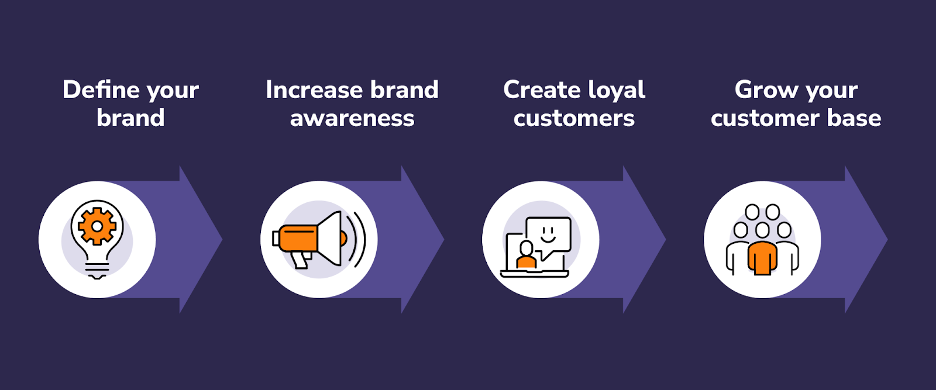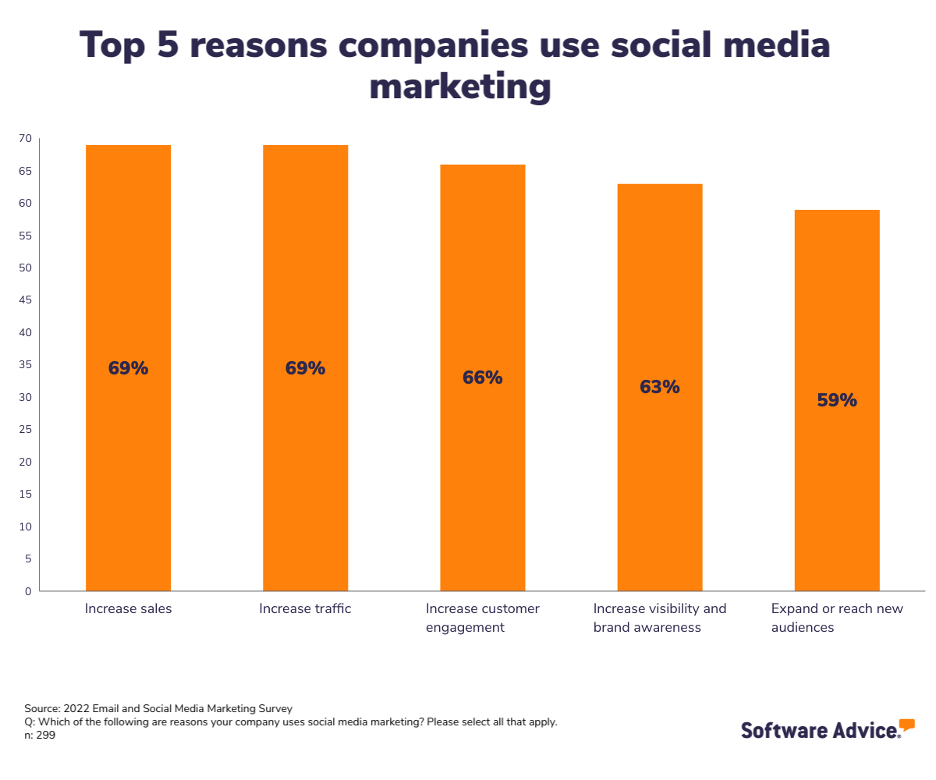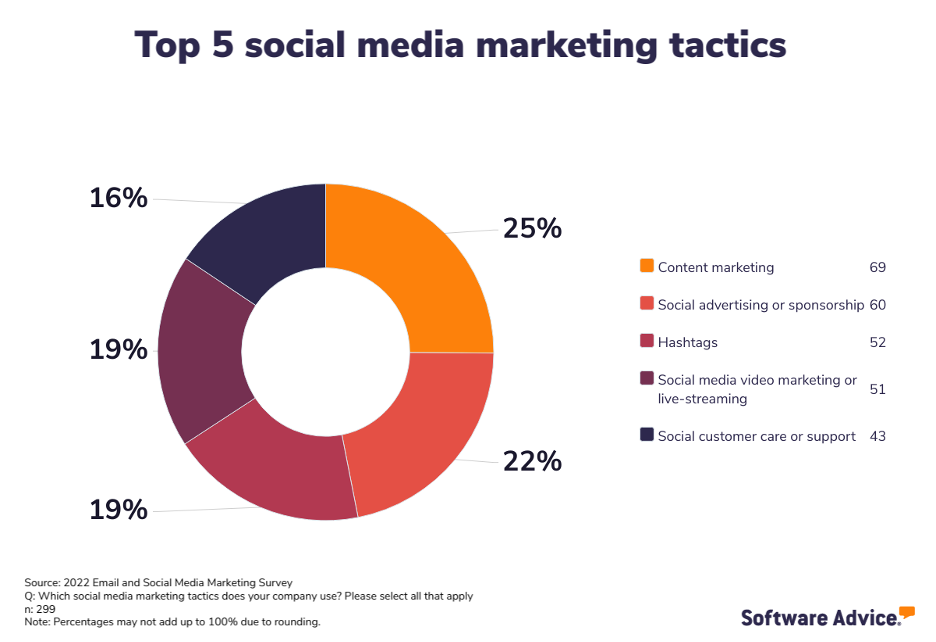3 Tips for Using Social Media Data Analysis to Achieve Channel Goals
Social media marketing can be an indispensable tool on your journey to grow revenue and your customer base.
Businesses that regard digital marketing as non-essential will quickly find themselves left out of the conversation and outpaced by their more social media-savvy competition.
CEO of Web Marketing Therapy, Lorrie Thomas Ross, says that when done right, “social media marketing works to boost credibility, visibility, and sellability”—all of which are integral components to growing your revenue and customer base.
In this article, we outline three best practices to help you put together an effective strategy for social media marketing and analysis so you can achieve these goals.
To create this list, we surveyed nearly 300 full-time marketing professionals to learn how they’re using social media data to achieve channel goals (see survey methodology at the end).
Here’s what we’ll cover:
1. Build your brand, then focus on increasing revenue
Defining your brand means you have identified the type of business you are, the type of customers you serve, and how you serve them. You’ve also directly tied the type of voice you will use to present your brand to consumers to your marketing and social media marketing strategy.
If you haven’t already defined your brand, that should be your first priority. Ross advises small to midsize businesses (SMBs) start with the “three V’s”:
Values: These are the core values shared by your organization and those you seek to engage.
Value: This is the value your organization delivers.
Voice: This is the voice you use to present your brand and values to the world.
Your brand is central to garnering loyal customers, which in turn grows your customer base.

You achieve brand loyalty by improving brand recognition and recall so consumers are more likely to choose your product or service over your competitors.
You might have short-term success if you skip defining your brand, but you’ll never enjoy a higher degree of customer loyalty without it.
The two biggest influencers of brand loyalty are brand consistency and brand authenticity. As such, maintaining consistency and authenticity with your brand’s message should be central to your marketing strategy.
Here’s how
(https://www.softwareadvice.com/resources/sales-and-marketing-strategy/ target=). You can use brand management software to help your company stay consistent in how it uses branded content (e.g., your logo, images and marketing copy).
Have an authentic voice to share brand values. If you spend thousands of dollars on a campaign, but your message is inauthentic or doesn’t resonate with your audience, all that effort will be for nothing. Remember that social media marketing is about connecting with people. So you need to have a deep understanding of your target audience, believe in the value your business provides and communicate that sincerely.
“Brands that know how to be human, relevant, and engaging are the ones who win.”
Lorrie Thomas Ross
CEO, Web Marketing Therapy, Inc.
Here’s why
Social media marketing and branding goals aren’t mutually exclusive. Increasing brand awareness will help you grow followers and boost traffic to your website, both benefits being among the top five social media marketing goals for respondents in our survey.

2. Connect social media data analysis efforts to revenue and customer growth
To ensure your marketing strategy is effective at growing your customer base and revenue (i.e., the “return”), you need to measure brand awareness and justify your marketing spend (i.e., your “investment”).
As such, it’s important to measure the “success” of each campaign. To do so, you have to track what resonates with social media consumers and what doesn’t.
If increasing brand awareness is your primary marketing goal, Ross says you should be tracking a number of metrics, such as:
Increases in positive reviews.
Increases in social media followers.
Increases in engagement on/from social media (e.g., comments, likes, shares, website traffic).
Increases in sales/conversions from social media channels.
Here’s how
Aggregate data from social media platforms, such as Facebook, Twitter, and LinkedIn, to monitor campaign performance and unify reporting. You can use social media analytics tools to track how one campaign performs against another or how your marketing efforts are performing against competitors. Compare changes in followers, social engagement on posts, click-throughs to your site and more.
Isolate top-performing campaigns and compare the message and targeting. This will not only help ensure you’re staying consistent with your brand, but will also help you replicate what performs well and avoid reproducing what doesn’t.
Note: It’s important to consider the scalability of a campaign when calculating ROI.
Ross says that investing in a video, for example, might feel expensive and time-consuming. However, if it’s a message that resonates with your audience and creates a powerful connection, it will elevate sales, credibility, and visibility.
“A video can be used on a website, and shared on a blog, YouTube, Vimeo, Facebook, and even broken up into multiple small videos for other social media,” Ross said.
Here’s why
Marketing professionals often struggle to understand why some campaigns work better than others.
If you’re looking to compare campaign success, look for social media analytics tools that focus on diagnostics. If you’re looking to calculate the ROI of campaigns, look for descriptive analytics tools.
3. Invest in tools that support your current processes
There are a variety of tools available that can help small businesses perform social media marketing and analytics—from marketing automation software, to campaign management and business intelligence tools.
It’s important to invest in tools that support your needs now, not a solution you hope to grow into. Small businesses especially can’t afford to pay for features they aren’t using.
Ross says she often gets asked to consult for small businesses that bought a stellar service, but don’t have anyone available or trained to use it. In addition to investing in tools that support your current workflows, she recommends making sure end-users are involved in the software selection process and trained on how to use the program.
Here’s how
Identify your main goals for social media marketing. That can include increasing brand awareness, increasing followers, content marketing, social listening, etc. Then, look for tools that support these goals.
Create a list of must-have vs. nice-to-have capabilities. This will help you narrow down your selection to a shortlist of products that meet your needs.
Provide teams with appropriate training on the tools. This step is essential if you want the tool to enhance and provide value. Evaluate the technical literacy of your staff. Will they need step-by-step training? Or, are they capable of learning the tool for themselves? Make sure you provide training for each type of user, so that your whole staff can use the tool effectively to achieve marketing goals.
Here’s why
We asked respondents to tell us why they use social media marketing. Your company may use social media marketing for one of these reasons or a combination—regardless, you’ll want to invest in social analytics tools that help bolster the processes you already have in place.
For example, if content marketing is your main tactic, consider a social media marketing platform or content management tool that helps you track clicks and opens, helps you publish content to social media pages, and monitor consumer reactions to your content.
Capturing data about social consumers can help you better understand your audience so you can target your brand’s message to their needs. And of course, keeping an eye on brand mentions over social channels allows you to make more informed investment decisions regarding future marketing efforts.

Use social media to meet your goals
Your social media marketing and analytics strategy can have a profound impact on your small business goals of growing revenue and your customer base.
When used correctly, the data you glean about social consumers can help you craft more effective brand messaging, measure the ROI of various campaigns, and improve your sellability. And these best practices are a good jumping off point for doing so.
To learn more about social media analytics tools, head over to our buyers guide. Once there, review common capabilities, compare solutions, and read reviews from real users.
Survey methodology
Software Advice conducted the Email and Social Media Marketing Survey in January of 2022 among 299 full-time marketing professionals. They must have been working within roles including advertising, brand management, customer experience or service, data and analytics, IT, marketing, product marketing and management, sales or strategic planning and be current email and social media marketing users. Eighty-three percent are from small to midsize businesses (SMBs) with 2,500 employees or fewer.